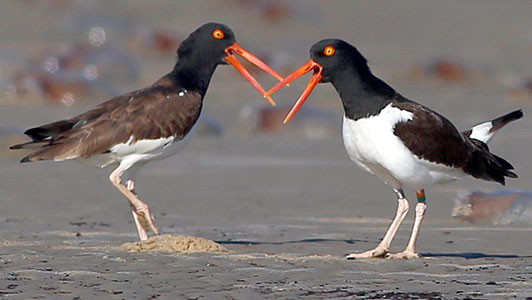

The Wicomico shoreline featured an unusually large barrier island, now called Trail Ridge. As a result, there is a large poorly drained area in Charlton and Ware counties. Marys River makes an even larger doglegin the opposite direction. The Ogeechee and Altamaha rivers break through these ridges and flow directly to the sea, but the Satilla River makes a twenty-mile dogleg in Wayne County, where it is trapped between the Penholoway and Talbot beach complexes, before it breaks through the latter to the sea. In some cases the sand ridges influence the present-day courses of several Georgia rivers. After the Wicomico barrier, several sequences of barrier islands occurred: Penholoway, which developed when sea level was about 75 feet above present level Talbot, 40-45 feet Pamlico, 25 feet Princess Anne, 15 feet and Silver Bluff, 5 feet. The furthermost of the Pleistocene shorelines is known as the Wicomico, which lies up to sixty miles west of the present Atlantic Ocean shore and developed when the sea level was approximately 100 feet higher than the present level. The terraces are visible as sand ridges and account for some relief in the otherwise flat and low-lying Lower Coastal Plain.Ĭourtesy of U.S.
#Barrier islands georgia series
Today, in cross section, the Barrier Island Sequence district resembles a series of steps, or terraces, descending to the sea.

The old shorelines, or terraces, formed where the fluctuating sea levels temporarily stopped or stabilized. The Pleistocene was a time of changing sea levels as the great continental glaciers of northern North America and Eurasia advanced and retreated, causing sea levels to rise and fall. The old shorelines were similar to Georgia’s present-day seashore, marked by sweeping salt marshes, tidal creeks, and short, wide barrier islands separated by deep sounds.Īt the beginning of the Pleistocene, most of southeast Georgia, a portion of southwest Georgia, and probably the entire Florida peninsula were beneath the sea and part of the continental shelf. The terraces represent primordial shorelines created by fluctuating sea levels. The parallel terraces were formed during the geologically recent Pleistocene epoch, also known as the Ice Ages, which began nearly 2 million years ago. The area is composed primarily of a series of six prehistoric terraces. The Barrier Island Sequence includes primordial seashores and the present-day coastline. The most notable of these districts are the Barrier Island Sequence and the Okefenokee Basin. The Lower Coastal Plain contains several subregions, or physiographic districts, based on topography, geology, soil, flora, fauna, and other factors. Land cover in the region is mostly slash and loblolly pine, with oak-gum-cypress forest in some low-lying areas, and pasture for beef cattle. The sand also actsas temporary storage space to absorb some of the flood flows. The sandy soil tends to absorb streamflow, especially during drought, when the water table falls. In inland areas of the Lower Coastal Plain, water depth fluctuates with rainfall and the seasons. Agricultural and most other commercial activities in the Lower Coastal Plain are concentrated on its higher and drier ground.

It is at a lower altitude and has less relief than the Upper Coastal Plain. The topography of the Lower Coastal Plain is generally low, flat, and swampy where it borders the Atlantic, and grades to low rolling hills at the inner margin. Its boundary stretches across the lower portion of the state from Screven County in southeast Georgia to Echols County to the southwest. That region extends inland about sixty-five to seventy miles from the seashore. In general, wildlife biologists and other experts refer to the Lower Coastal Plain as the area roughly covering a twenty-seven-county “ecoregion” designated as the Southern Coastal Plain. Geologists, biologists, and other scientists disagree on the extent of the area occupied by the region. Courtesy of Georgia Department of Economic Development.


 0 kommentar(er)
0 kommentar(er)
